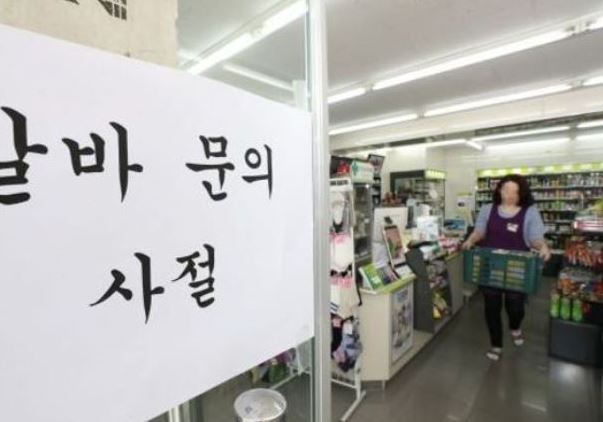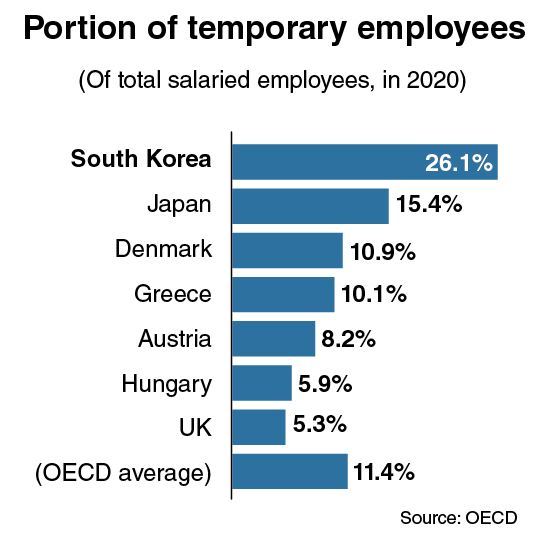 |
A notification on the window of a convenience store reads that the owner has no intention to hire workers amid growing burden of labor costs. (Yonhap) |
SEJONG -- There is a high possibility that South Korea will receive the undesirable top spot in the proportion of temporary workers among major economies worldwide in the coming years, global comparison data has shown.
According to the Organization for Economic Cooperation and Development, Korea ranked second in the portion of temporary workers of the total salaried jobs in 2020, with 26.1 percent.
This was an increase from ranking fourth among 35 OECD members in 2019 (with 24.4 percent) and No. 7 (with 21.2 percent). Of the total 37 members, two -- Israel and Mexico -- were not included in the Paris-based organization’s analysis.
A temporary employee refers to a salaried worker whose job has a predetermined termination date, according to the OECD definition. People in this category, alongside part-time or contract workers, are classified as “nonregular workers” in Korea.
Over the past two years, Korea overtook the Netherlands, Portugal, Poland, Spain and Chile in its reliance on temporary labor.
 |
(Graphic by Kim Sun-young/The Korea Herald) |
Given that the figure held by Colombia (No. 1) continued to fall -- from 28.8 percent in 2018 to 28.76 percent in 2019 and 27.3 percent in 2020 -- Korea will possibly top the list in 2021 or 2022.
The figure for Korea is quite high compared to the European Union average of 13.6 percent, the OECD average of 11.4 percent and the Group of Seven average of 8.6 percent as of 2020. It is also far higher than the figures held by neighbors in the Asia-Pacific region: 15.4 percent in Japan and 7.6 percent in New Zealand.
Many emerging economies posted figures lower than Korea’s. Slovenia and Turkey stood at No. 17 and No. 19, respectively, on the list, with temporary workers making up 10.9 percent and 10.8 percent of all salaried workers.
Others with fewer temporary workers in proportion to their salaried workforces were Greece at 10.1 percent, the Czech Republic at 7.4 percent, the Slovak Republic at 6.8 percent and Hungary at 5.9 percent.
Countries that recorded figures under 5 percent included the Baltic countries -- Estonia with 2.8 percent, Latvia with 2.8 percent and Lithuania with 1.3 percent.
Among the countries whose figures were under the OECD average were Denmark (10.9 percent), Iceland (8.2 percent), Norway (7.8 percent), Luxembourg with (7.7 percent) and the UK (5.3 percent).
Korea’s official jobless rate, publicized by the government, stayed at 4 percent in May, which could mean the number of unemployed stayed at only 1.14 million.
But the tally for de facto unemployed -- which includes the underemployed -- has reached 4.12 million, with the de facto jobless rate at 13.5 percent, according to Statistics Korea. Underemployed people are defined as those who work fewer than 36 hours a week and want to work more, as well as seasonal workers who are out of work for part of the year.
Statistics Korea data showed that the number of nonregular workers -- the broader category that includes temporary workers -- surged by more than 800,000 in only three years from 6.57 million in 2017 to 7.42 million in 2020.
In contrast, the number of regular employees dropped by about 400,000 from 13.42 million to 13.02 million over the corresponding period.
As a result, the percentage of nonregular workers among salaried employees has climbed from 32.9 percent in 2017, when the Moon Jae-in administration took office, to 36.3 percent in 2020.
By Kim Yon-se (
kys@heraldcorp.com)






![[Exclusive] Hyundai Mobis eyes closer ties with BYD](http://res.heraldm.com/phpwas/restmb_idxmake.php?idx=644&simg=/content/image/2024/11/25/20241125050044_0.jpg)
![[Herald Review] 'Gangnam B-Side' combines social realism with masterful suspense, performance](http://res.heraldm.com/phpwas/restmb_idxmake.php?idx=644&simg=/content/image/2024/11/25/20241125050072_0.jpg)

